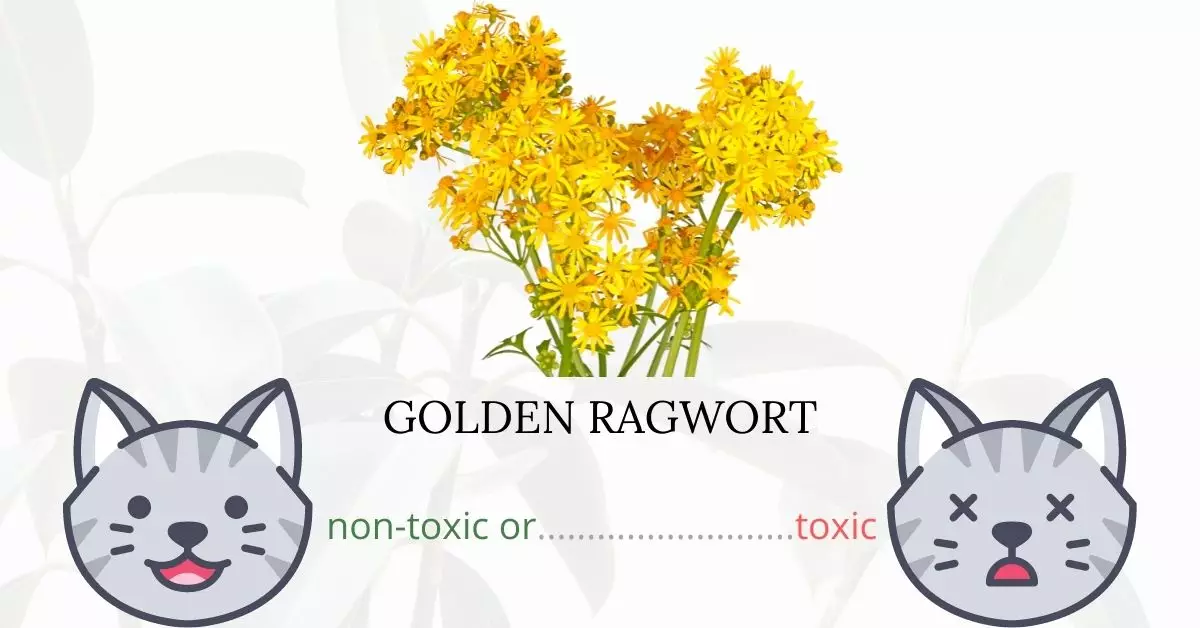Golden Ragwort, also simply known as ragwort, is indeed a perilous plant for cats, harboring the potential to inflict severe harm if ingested. It is a perennial flowering plant, historically utilized by humans for medicinal applications, but it should strictly be off-limits for our feline friends due to its content of pyrrolizidine alkaloids, substances that are detrimental to the liver. Ingesting even minimal amounts can lead to life-threatening consequences such as liver failure, hemorrhage due to ruptured blood vessels, and in severe cases, abrupt death.
This article is penned with insights and meticulous verification from a panel of seasoned Doctors of Veterinary Medicine (DVMs), ensuring the provision of accurate and current information regarding the risks associated with various plants, particularly focusing on Golden Ragwort in this context, and their implications for cats. These expert contributions enable a comprehensive exploration of potential hazards and an authoritative response to the posed concerns. To further validate the reliability of our information, extensive research was conducted, consulting high-authority sources including the ASPCA and PetMD, reinforcing our commitment to delivering credible and well-rounded perspectives on every plant discussed.
It is crucial to note that despite the plant’s unfavorable taste, which generally deters animals, cases of long-term exposure are not rare. In such instances, the liver manifests cumulative and progressive damage from continuous intake of even minimal toxin doses over time. The emphasis, therefore, should be on preventing any exposure of cats to Golden Ragwort to safeguard their well-being.
Clinical Signs of Golden Ragwort Poisoning in Cats
When a cat comes into contact with, inhales, or, more severely, ingests Golden Ragwort, the ensuing clinical manifestations can be critical and necessitate immediate veterinary intervention. Golden Ragwort poisoning can precipitate acute or chronic liver damage, and it can take up to a week for the symptoms to fully materialize. Below are the detailed signs and the associated physiological alterations caused by the exposure to this toxic plant:
- Loss of Appetite: Cats suffering from ragwort poisoning may exhibit a significant decrease in appetite due to the discomfort and pain caused by the internal damage inflicted by the plant’s toxins. This reluctance to eat is often one of the earliest signs of poisoning.
- Diarrhea and Vomiting: The ingestion of ragwort can irritate the gastrointestinal tract, leading to episodes of diarrhea and vomiting, as the body attempts to expel the harmful substances.
- Muddy Mucous Membranes: The presence of abnormal, dark-colored mucous membranes is indicative of internal bleeding or poor oxygenation, often associated with severe liver damage caused by the toxins.
- Behavioral Changes: Behavioral alterations may occur due to the discomfort and pain experienced by the cat, or as a result of the toxins affecting the cat’s neurological system, making them appear agitated, distressed, or unusually lethargic.
- Sunburn of Hairless Areas of the Body: The damage to the liver can result in photosensitization, making the skin more susceptible to sunlight, especially in hairless or lightly haired areas, leading to sunburn.
- Body Weakness: The overall toxicity can lead to profound weakness as the body’s systems are compromised, and the cat’s energy levels and muscle strength deplete.
- Ataxia: Incoordination or unsteady and uncoordinated movements, termed as ataxia, can emerge due to the impact of toxins on the neurological system.
- Liver Damage: The pyrrolizidine alkaloids in Golden Ragwort specifically target the liver, causing extensive damage, and can be fatal if not addressed promptly. This liver damage is the underlying cause of many of the aforementioned symptoms.
Awareness and vigilance regarding these symptoms are paramount for cat owners, as early detection and intervention can significantly improve the prognosis for cats exposed to Golden Ragwort. If any of these symptoms are observed, immediate veterinary consultation is imperative.
First Aid and Treatment of Golden Ragwort Poisoning in Cats
The vet will induce vomiting so that any lingering golden ragwort in your cat’s stomach can be expelled. Your cat will also receive activated charcoal treatment, which will allow any lingering toxins to adhere to the charcoal and be safely removed from its body. The veterinarian will treat the cat’s symptoms and do thorough disinfection. Stomach pumping or gastric lavage are examples of this.
If the symptoms of your cat are not caught early enough, this may lead to permanent liver damage. Treatment will be supportive because your cat will not be able to regain its prior level of health. The cat’s health will worsen over time, and the goal of care will be to keep it as comfortable as possible.
Recovery from Golden Ragwort Poisoning in Cats
After being poisoned by golden ragwort, your cat’s health will be chronically harmed. You’ll be able to take your cat home with you, but you’ll only be able to give it supportive care and make him or her comfortable.
Continue to keep an eye on your cat’s health, noting any signs of liver failure. Return to the vet for treatment if you see anything that indicates it’s becoming worse. If the poisoning’s consequences are extreme or the cat’s condition worsens, humane euthanasia may be considered.
Prevention of Golden Ragwort Poisoning in Cats
The best method to avoid poisoning in cats or other animals is to remove ragwort from the environment. It is advisable to use gloves and remove the plants by hand. You can also burn the plant once it’s been dug out. It’s possible that keeping your cat indoors will keep it from getting into contact with ragwort or other harmful plants.
If you love plants but have cats at home, check out these lists:





